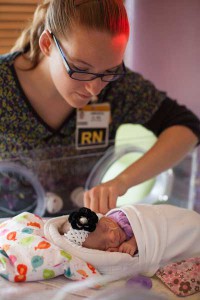Day in the Life: NICU Nurse

 Amanda Gibbons usually begins her work day when the sun’s about to set. She works as a nurse in the neonatal intensive care unit at Women’s and Children’s Hospital to ensure that sick babies make it through the night, even if it means her own sleep schedule is a bit unusual. Amanda knew she wanted to work as a NICU nurse since she graduated from nursing school in 2009. “I needed a challenge, and I knew I liked to help people,” she says about her decision to make nursing a career. Now between spending time with her three sons and tending to her family’s needs, Amanda works three 12-hour shifts per week at the hospital.
Amanda Gibbons usually begins her work day when the sun’s about to set. She works as a nurse in the neonatal intensive care unit at Women’s and Children’s Hospital to ensure that sick babies make it through the night, even if it means her own sleep schedule is a bit unusual. Amanda knew she wanted to work as a NICU nurse since she graduated from nursing school in 2009. “I needed a challenge, and I knew I liked to help people,” she says about her decision to make nursing a career. Now between spending time with her three sons and tending to her family’s needs, Amanda works three 12-hour shifts per week at the hospital.
3 p.m.
Wake up in the “morning”: Amanda starts her day as soon as her children come home from school. Working the night shift ensures she can help the boys with their homework first. “The night shift works for my routine, as opposed to the day shift when I wouldn’t get home until [8 p.m.], and that’s too late to help my kids,” she says. “My main goal is helping my children.”
4:30 to 5:30 p.m.
Transition time: Amanda cooks dinner and eats with her family. She leaves the house around 6 p.m. because she has to travel 40 minutes to get to the hospital.
7 p.m.
 Getting the lowdown: The hospital shift begins with a group huddle including all of the NICU staff. The nurses receive a general report of the unit’s current circumstances and assignments for the individual patient statuses.
Getting the lowdown: The hospital shift begins with a group huddle including all of the NICU staff. The nurses receive a general report of the unit’s current circumstances and assignments for the individual patient statuses.
7:30 p.m.
Prepping the infants: There are generally two babies in each room, and Amanda checks their heart tones, breath sounds, stomach sounds and pulses every three hours. During this time, she also feeds them and changes their diapers and linens. These assessments take 30 to 45 minutes to perform.
8:15 p.m.
 Between shifts: “The clinical supervisor comes around the unit for briefings,” Amanda says. “The resident physicians, neonatal nurse practitioners, respiratory therapists, transport team and staff nurses all attend this, and we all voice concerns and needs at this time.” Between direct patient care, Amanda also informs new unit nurses about policies and procedures, cleans the bedsides, stocks the room full of supplies or even holds the baby patients.
Between shifts: “The clinical supervisor comes around the unit for briefings,” Amanda says. “The resident physicians, neonatal nurse practitioners, respiratory therapists, transport team and staff nurses all attend this, and we all voice concerns and needs at this time.” Between direct patient care, Amanda also informs new unit nurses about policies and procedures, cleans the bedsides, stocks the room full of supplies or even holds the baby patients.
Midnight.
Parental involvement: Amanda helps educate parents sitting bedside on how best to care for their babies as they transition to going home. “We do education from the time they’re admitted to the time they’re discharged,” she says. “We’re constantly trying to teach them why their infants are doing what they’re doing and why we do what we do as far as labs or procedures.”
4:45 a.m.
Sets of care: After the third set of care, Amanda performs ordered lab draws to assess changes in the infant. “Throughout the shift, we also sometimes need to start IVs as they go bad or if something is changing with the infant,” she says.
7 a.m.
 Rotating out: The next shift overlaps with Amanda’s when the other nurse comes in at 7 a.m. At the bedside, Amanda gives a full report on the infant, and afterwards the two do a safety check together to make sure the baby’s syringes, alarm parameters, etc. are all working. Together, they sign a checklist.
Rotating out: The next shift overlaps with Amanda’s when the other nurse comes in at 7 a.m. At the bedside, Amanda gives a full report on the infant, and afterwards the two do a safety check together to make sure the baby’s syringes, alarm parameters, etc. are all working. Together, they sign a checklist.
8:15 a.m.
All in a day’s work: Amanda usually arrives home, jumps in the shower and goes straight to bed on the days she has shifts, which are Thursday, Friday and Saturday. “I’m part of the weekend program because I like my days in a row,” she says. “That way, I can get them done, and then I switch back to a regular day-shift kind of person.”


